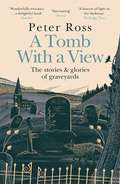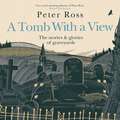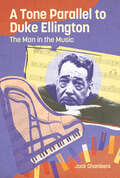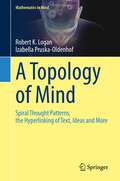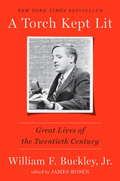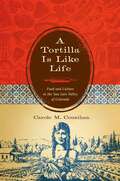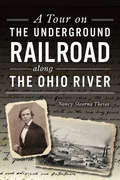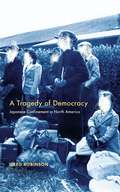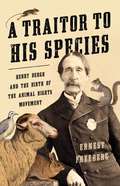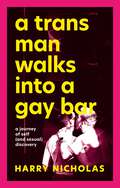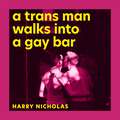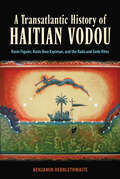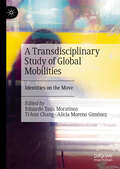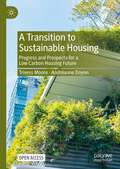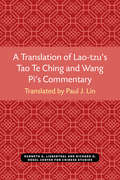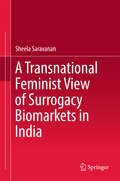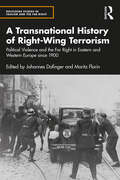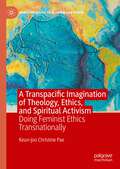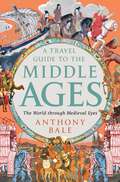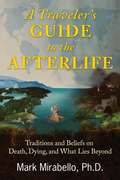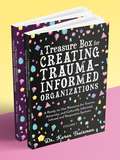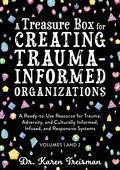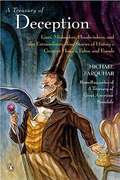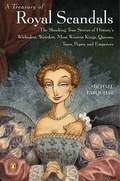- Table View
- List View
A Tomb With a View – The Stories & Glories of Graveyards: A Financial Times Book of the Year
by Peter RossA FINANCIAL TIMES, I PAPER AND STYLIST BOOK OF THE YEAR'In his absorbing book about the lost and the gone, Peter Ross takes us from Flanders Fields to Milltown to Kensal Green, to melancholy islands and surprisingly lively ossuaries . . . a considered and moving book on the timely subject of how the dead are remembered, and how they go on working below the surface of our lives.' - Hilary Mantel'Ross is a wonderfully evocative writer, deftly capturing a sense of place and history, while bringing a deep humanity to his subject. He has written a delightful book.' - The Guardian'The pages burst with life and anecdote while also examining our relationship with remembrance.' - Financial Times (best travel books of 2020)'Among the year's most surprising "sleeper" successes is A Tomb with a View. In a year with so much death, it may have initially seemed a hard sell, but the author's humanity has instead acted as a beacon of light in the darkness.' -The Sunday Times'Fascinating . . . Ross makes a likeably idiosyncratic guide and one finishes the book feeling strangely optimistic about the inevitable.' - The Observer'Ross has written [a] lively elegy to Britain's best burial grounds.' - Evening Standard (*Best New Books of Autumn 2020*)'One of the non-fiction books of the year.' - The i paper (*2020 Best Books for Christmas*)'Brilliant.' - Stylist (*Best Christmas books for Christmas 2020*)'Never has a book about death been so full of life. James Joyce and Charles Dickens would've loved it - a book that reveals much gravity in the humour and many stories in the graveyard. It also reveals Peter Ross to be among the best non-fiction writers in the country.' - Andrew O'HaganFor readers of The Salt Path, Mudlarking, Ghostland, Kathleen Jamie and Robert Macfarlane. Enter a grave new world of fascination and delight as award-winning writer Peter Ross uncovers the stories and glories of graveyards. Who are London's outcast dead and why is David Bowie their guardian angel? What is the remarkable truth about Phoebe Hessel, who disguised herself as a man to fight alongside her sweetheart, and went on to live in the reigns of five monarchs? Why is a Bristol cemetery the perfect wedding venue for goths? All of these sorrowful mysteries - and many more - are answered in A Tomb With A View, a book for anyone who has ever wandered through a field of crooked headstones and wondered about the lives and deaths of those who lie beneath.
A Tomb With a View – The Stories & Glories of Graveyards: Scottish Non-fiction Book of the Year 2021
by Peter Ross'In his absorbing book about the lost and the gone, Peter Ross takes us from Flanders Fields to Milltown to Kensal Green, to melancholy islands and surprisingly lively ossuaries . . . a considered and moving book on the timely subject of how the dead are remembered, and how they go on working below the surface of our lives.' - Hilary Mantel'Never has a book about death been so full of life. James Joyce and Charles Dickens would've loved it - a book that reveals much gravity in the humour and many stories in the graveyard. It also reveals Peter Ross to be among the best non-fiction writers in the country.' - Andrew O'Hagan'His stories are always a joy' - Ian Rankin'I'm a card-carrying admirer of Peter Ross' - Robert Macfarlane'A startling, delight-filled tour of graveyards and the people who love them, dazzlingly told.' - Denise Mina'A phenomenal, lyrical, beautiful book.' - Frank TurnerFor readers of The Salt Path, Mudlarking, Ghostland, Kathleen Jamie and Robert Macfarlane.Enter a grave new world of fascination and delight as award-winning writer Peter Ross uncovers the stories and glories of graveyards. Who are London's outcast dead and why is David Bowie their guardian angel? What is the remarkable truth about Phoebe Hessel, who disguised herself as a man to fight alongside her sweetheart, and went on to live in the reigns of five monarchs? Why is a Bristol cemetery the perfect wedding venue for goths?All of these sorrowful mysteries - and many more - are answered in A Tomb With A View, a book for anyone who has ever wandered through a field of crooked headstones and wondered about the lives and deaths of those who lie beneath.So push open the rusting gate, push back the ivy, and take a look inside...(P)2020 Headline Publishing Group Limited
A Tone Parallel to Duke Ellington: The Man in the Music (American Made Music Series)
by Jack ChambersIn this insightful new volume, Jack Chambers explores Edward Kennedy “Duke” Ellington’s music thematically, collating motifs, memes, and predilections that caught Ellington's attention and inspired his restless muse. In presenting Ellington’s work in this manner, Chambers situates the music in the context in which it was created—historical, political, musical, biographic, and personal. Chambers offers a novel kind of access to the man and the music. Ellington’s music presents a daunting task for listeners because of its sheer volume. The numbers defy credulity. Ellington (1899–1974) wrote more than two thousand compositions in numerous genres, including pop songs, big band swing, revues, hymns, tone poems, soundtracks, suites, ballets, concertos, and symphonies. Where to start? The themes in this book offer natural entry points. They provide the context in which the music came into being, with enough biography to satisfy music lovers, even those who come to the book knowing very little about Ellington’s life. Each chapter features its own playlist as a guide to the music discussed, and, in some cases, fuller listings in case readers might want to pursue a topic further. In the early chapters, Chambers covers topics that occupied Ellington through much of his career, and in later chapters he covers more specific themes, some of them from Ellington's last decades, which are less well studied. The music, Ellington said, is his “continuing autobiography,” and it reveals the man behind it.
A Topology of Mind: Spiral Thought Patterns, the Hyperlinking of Text, Ideas and More (Mathematics in Mind)
by Robert K. Logan Izabella Pruska-OldenhofThis volume covers many diverse topics related in varying degrees to mathematics in mind including the mathematical and topological structures of thought and communication. It examines mathematics in mind from the perspective of the spiral, cyclic and hyperlinked structures of the human mind in terms of its language, its thoughts and its various modes of communication in science, philosophy, literature and the arts including a chapter devoted to the spiral structure of the thought of Marshall McLuhan. In it, the authors examine the topological structures of hypertext, hyperlinking, and hypermedia made possible by the Internet and the hyperlinked structures that existed before its emergence. It also explores the cognitive origins of mathematical thinking of the human mind and its relation to the emergence of spoken language, and studies the emergence of mathematical notation and its impact on education. Topics addressed include:• The historical context of any topic that involves how mathematical thinking emerged, focusing on archaeological and philological evidence. • Connection between math cognition and symbolism, annotation and other semiotic processes. • Interrelationships between mathematical discovery and cultural processes, including technological systems that guide the thrust of cognitive and social evolution. • Whether mathematics is an innate faculty or forged in cultural-historical context• What, if any, structures are shared between mathematics and language
A Torch Kept Lit: Great Lives of the Twentieth Century
by William F. Buckley James RosenWilliam F. Buckley, Jr. remembers--as only he could--the towering figures of the twentieth century in a brilliant and emotionally powerful collection, compiled by acclaimed Fox News correspondent James Rosen.In a half century on the national stage, William F. Buckley, Jr. achieved unique stature as a writer, a celebrity, and the undisputed godfather of modern American conservatism. He kept company with the best and brightest, the sultry and powerful. Ronald Reagan pronounced WFB "perhaps the most influential journalist and intellectual in our era," and his jet-setting life was a who's who of high society, fame, and fortune. Among all his distinctions, which include founding the conservative magazine National Review and hosting the long-running talk show Firing Line, Buckley was also a master of that most elusive art form: the eulogy. He drew on his unrivaled gifts to mourn, celebrate, or seek mercy for the men and women who touched his life and the nation. Now, for the first time, WFB's sweeping judgments of the great figures of his time--presidents and prime ministers, celebrities and scoundrels, intellectuals and guitar gods--are collected in one place. A Torch Kept Lit presents more than fifty of Buckley's best eulogies, drawing on his personal memories and private correspondences and using a novelist's touch to conjure his subjects as he knew them. We are reintroduced, through Buckley's eyes, to the likes of Winston Churchill and Ronald Reagan, Elvis Presley and John Lennon, Truman Capote and Martin Luther King, Jr.Curated by Fox News chief Washington correspondent James Rosen, a Buckley protégé and frequent contributor to National Review, this volumes heds light on a tumultuous period in American history--from World War II to Watergate, the "death" of God to the Grateful Dead--as told in the inimitable voice of one of our most elegant literary stylists.William F. Buckley, Jr. is back--just when we need him most.From the Hardcover edition.
A Tortilla Is Like Life: Food and Culture in the San Luis Valley of Colorado (Louann Atkins Temple Women & Culture Series)
by Carole M. CounihanAn innovative portrait of a small Colorado town based on a decade&’s worth of food-centered life histories from nineteen of its female residents.Located in the southern San Luis Valley of Colorado, the remote and relatively unknown town of Antonito is home to an overwhelmingly Hispanic population struggling not only to exist in an economically depressed and politically marginalized area, but also to preserve their culture and their lifeways. Between 1996 and 2006, anthropologist Carole Counihan collected food-centered life histories from nineteen Mexicanas―Hispanic American women―who had long-standing roots in the Upper Rio Grande region. The interviews in this groundbreaking study focused on southern Colorado Hispanic foodways―beliefs and behaviors surrounding food production, distribution, preparation, and consumption.In this book, Counihan features extensive excerpts from these interviews to give voice to the women of Antonito and highlight their perspectives. Three lines of inquiry are framed: feminist ethnography, Latino cultural citizenship, and Chicano environmentalism. Counihan documents how Antonito&’s Mexicanas establish a sense of place and belonging through their knowledge of land and water and use this knowledge to sustain their families and communities. Women play an important role by gardening, canning, and drying vegetables; earning money to buy food; cooking; and feeding family, friends, and neighbors on ordinary and festive occasions. They use food to solder or break relationships and to express contrasting feelings of harmony and generosity, or enmity and envy. The interviews in this book reveal that these Mexicanas are resourceful providers whose food work contributes to cultural survival.&“An important contribution to Mexican American culture.&” ―Oral History Review&“Counihan&’s book is well written and will appeal to a wide spectrum of readers . . . I would recommend this book to those whose interests lie in foodways, gender studies, ethnography and folklore. A Tortilla is Like Life would be a good addition to any reading list, and a beneficial resource for those who desire to understand the complex associations of gender, food, culture and ethnicity.&” —Digest: A Journal of Foodways and Culture
A Tortilla Is Like Life: Food and Culture in the San Luis Valley of Colorado (Louann Atkins Temple Women & Culture Series)
by Carole M. CounihanAn innovative portrait of a small Colorado town based on a decade&’s worth of food-centered life histories from nineteen of its female residents.Located in the southern San Luis Valley of Colorado, the remote and relatively unknown town of Antonito is home to an overwhelmingly Hispanic population struggling not only to exist in an economically depressed and politically marginalized area, but also to preserve their culture and their lifeways. Between 1996 and 2006, anthropologist Carole Counihan collected food-centered life histories from nineteen Mexicanas―Hispanic American women―who had long-standing roots in the Upper Rio Grande region. The interviews in this groundbreaking study focused on southern Colorado Hispanic foodways―beliefs and behaviors surrounding food production, distribution, preparation, and consumption.In this book, Counihan features extensive excerpts from these interviews to give voice to the women of Antonito and highlight their perspectives. Three lines of inquiry are framed: feminist ethnography, Latino cultural citizenship, and Chicano environmentalism. Counihan documents how Antonito&’s Mexicanas establish a sense of place and belonging through their knowledge of land and water and use this knowledge to sustain their families and communities. Women play an important role by gardening, canning, and drying vegetables; earning money to buy food; cooking; and feeding family, friends, and neighbors on ordinary and festive occasions. They use food to solder or break relationships and to express contrasting feelings of harmony and generosity, or enmity and envy. The interviews in this book reveal that these Mexicanas are resourceful providers whose food work contributes to cultural survival.&“An important contribution to Mexican American culture.&” ―Oral History Review&“Counihan&’s book is well written and will appeal to a wide spectrum of readers . . . I would recommend this book to those whose interests lie in foodways, gender studies, ethnography and folklore. A Tortilla is Like Life would be a good addition to any reading list, and a beneficial resource for those who desire to understand the complex associations of gender, food, culture and ethnicity.&” —Digest: A Journal of Foodways and Culture
A Tour on the Underground Railroad along the Ohio River (History & Guide)
by Nancy Stearns TheissRunning for 664 miles along Kentucky's border, the Ohio River provided a remarkable opportunity for the enslaved to escape to free soil in Indiana and Ohio. The river beckoned fugitive slave Henry Bibb onto a steamboat at Madison, Indiana, headed to Cincinnati, where he discovered the Underground Railroad. Upriver from Cincinnati, a lantern signal high on a hill from the Rankin House in Ripley, Ohio, stirred others to flee for freedom. These stories and more along the borderland of the Ohio River also served as the setting for Harriet Beecher Stowe's novel Uncle Tom's Cabin, which became an inspiration of human resistance. Author Nancy Theiss, PhD, takes readers on a tour through American history to places of courage and sacrifice.
A Tragedy of Democracy: Japanese Confinement in North America
by Greg RobinsonThe confinement of some 120,000 Japanese Americans during World War II, often called the Japanese American internment, has been described as the worst official civil rights violation of modern U. S. history. Greg Robinson not only offers a bold new understanding of these events but also studies them within a larger time frame and from a transnational perspective. Drawing on newly discovered material, Robinson provides a backstory of confinement that reveals for the first time the extent of the American government's surveillance of Japanese communities in the years leading up to war and the construction of what officials termed "concentration camps" for enemy aliens. He also considers the aftermath of confinement, including the place of Japanese Americans in postwar civil rights struggles, the long movement by former camp inmates for redress, and the continuing role of the camps as touchstones for nationwide commemoration and debate. Most remarkably, A Tragedy of Democracy is the first book to analyze official policy toward West Coast Japanese Americans within a North American context. Robinson studies confinement on the mainland alongside events in wartime Hawaii, where fears of Japanese Americans justified Army dictatorship, suspension of the Constitution, and the imposition of military tribunals. He similarly reads the treatment of Japanese Americans against Canada's confinement of 22,000 citizens and residents of Japanese ancestry from British Columbia. A Tragedy of Democracy recounts the expulsion of almost 5,000 Japanese from Mexico's Pacific Coast and the poignant story of the Japanese Latin Americans who were kidnapped from their homes and interned in the United States. Approaching Japanese confinement as a continental and international phenomenon, Robinson offers a truly kaleidoscopic understanding of its genesis and outcomes. The confinement of some 120,000 Japanese Americans during World War II, often called the Japanese American internment, has been described as the worst official civil rights violation of modern U. S. history. Greg Robinson not only offers a bold new understanding of these events but also studies them within a larger time frame and from a transnational perspective. Drawing on newly discovered material, Robinson provides a backstory of confinement that reveals for the first time the extent of the American government's surveillance of Japanese communities in the years leading up to war and the construction of what officials termed "concentration camps" for enemy aliens. He also considers the aftermath of confinement, including the place of Japanese Americans in postwar civil rights struggles, the long movement by former camp inmates for redress, and the continuing role of the camps as touchstones for nationwide commemoration and debate. Most remarkably, A Tragedy of Democracy is the first book to analyze official policy toward West Coast Japanese Americans within a North American context. Robinson studies confinement on the mainland alongside events in wartime Hawaii, where fears of Japanese Americans justified Army dictatorship, suspension of the Constitution, and the imposition of military tribunals. He similarly reads the treatment of Japanese Americans against Canada's confinement of 22,000 citizens and residents of Japanese ancestry from British Columbia. A Tragedy of Democracy recounts the expulsion of almost 5,000 Japanese from Mexico's Pacific Coast and the poignant story of the Japanese Latin Americans who were kidnapped from their homes and interned in the United States. Approaching Japanese confinement as a continental and international phenomenon, Robinson offers a truly kaleidoscopic understanding of its genesis and outcomes.
A Traitor to His Species: Henry Bergh and the Birth of the Animal Rights Movement
by Ernest FreebergFrom an award-winning historian, the outlandish story of the man who gave rights to animals.In Gilded Age America, people and animals lived cheek-by-jowl in environments that were dirty and dangerous to man and beast alike. The industrial city brought suffering, but it also inspired a compassion for animals that fueled a controversial anti-cruelty movement. From the center of these debates, Henry Bergh launched a shocking campaign to grant rights to animals.A Traitor to His Species is revelatory social history, awash with colorful characters. Cheered on by thousands of men and women who joined his cause, Bergh fought with robber barons, Five Points gangs, and legendary impresario P.T. Barnum, as they pushed for new laws to protect trolley horses, livestock, stray dogs, and other animals. Raucous and entertaining, A Traitor to His Species tells the story of a remarkable man who gave voice to the voiceless and shaped our modern relationship with animals.
A Trans Man Walks Into a Gay Bar: A Journey of Self (and Sexual) Discovery
by Harry Nicholas'On the bookshelves, there was plenty of stuff on being gay, and much needed, joyous accounts of what it is to be trans, but nothing really that encapsulates what is it to be both - to exist in the hazy terrain between.'After his relationship with his girlfriend of 5 years ended, Harry realised he was a single adult for the first time - not only that, but a single, transmasculine and newly out gay man.Despite knowing it was the right decision, the reality of his new situation was terrifying. How could he be a gay man, when he was still learning what it was to be a man? Would the gay community embrace him or reject him? What would gay sex be like? And most importantly, would finding love again be possible?In this raw, intimate and unflinchingly honest book, we follow Harry as he navigates the sometimes fraught and contradictory worlds of contemporary gay culture as a trans gay man, from Grindr, dating and gay bars, to saunas, sex and ultimately, falling in love. Harry's brave and uplifting journey will show you there is joy in finding who you are.
A Trans Man Walks Into a Gay Bar: A Journey of Self (and Sexual) Discovery
by Harry NicholasLONGLISTED FOR THE POLARI PRIZE 2024'On the bookshelves, there was plenty of stuff on being gay, and much needed, joyous accounts of what it is to be trans, but nothing really that encapsulates what is it to be both - to exist in the hazy terrain between.'After his relationship with his girlfriend of 5 years ended, Harry realised he was a single adult for the first time - not only that, but a single, transmasculine and newly out gay man.Despite knowing it was the right decision, the reality of his new situation was terrifying. How could he be a gay man, when he was still learning what it was to be a man? Would the gay community embrace him or reject him? What would gay sex be like? And most importantly, would finding love again be possible?In this raw, intimate and unflinchingly honest book, we follow Harry as he navigates the sometimes fraught and contradictory worlds of contemporary gay culture as a trans gay man, from Grindr, dating and gay bars, to saunas, sex and ultimately, falling in love. Harry's brave and uplifting journey will show you there is joy in finding who you are.
A Transatlantic History of Haitian Vodou: Rasin Figuier, Rasin Bwa Kayiman, and the Rada and Gede Rites
by Benjamin HebblethwaiteConnecting four centuries of political, social, and religious history with fieldwork and language documentation, A Transatlantic History of Haitian Vodou analyzes Haitian Vodou’s African origins, transmission to Saint-Domingue, and promulgation through song in contemporary Haiti.Split into two sections, the African chapters focus on history, economics, and culture in Dahomey, Allada, and Hueda while scrutinizing the role of Europeans in fomenting tensions. The political, military, and slave trading histories of the kingdoms in the Bight of Benin reveal the circumstances of enslavement, including the geographies, ethnicities, languages, and cultures of enslavers and enslaved. The study of the spirits, rituals, structure, and music of the region’s religions sheds light on important sources for Haitian Vodou. Having royal, public, and private expressions, Vodun spirit-based traditions served as cultural systems that supported or contested power and enslavement. At once suppliers and victims of the European slave trade, the people of Dahomey, Allada, and Hueda deeply shaped the emergence of Haiti’s creolized culture. The Haitian chapters focus on Vodou’s Rada Rite (from Allada) and Gede Rite (from Abomey) through the songs of Rasin Figuier’s Vodou Lakay and Rasin Bwa Kayiman’s Guede, legendary rasin compact discs released on Jean Altidor’s Miami label, Mass Konpa Records. All the Vodou songs on the discs are analyzed with a method dubbed “Vodou hermeneutics” that harnesses history, religious studies, linguistics, literary criticism, and ethnomusicology in order to advance a scholarly approach to Vodou songs.
A Transdisciplinary Study of Global Mobilities: Identities on the Move
by Eduardo Tasis Moratinos Ti-Han Chang Alícia Moreno GiménezIdentities on the Move interrogates the categories given and adopted by people on the move through a transdisciplinary and global approach that includes social and political sciences and the arts. It brings together experiences of displacement from a variety of cultural and national backgrounds, including Brazilians, Chinese, Koreans, South Italians, Africans, Muslims, Arabophobe migrants, Iranians, Pakistanis, Bosnians, Latin Americans and Eastern Europeans. It looks at their identity-negotiating processes in different geographies across the globe, namely Japan, UK, Palestine, Italy, Australia, Europe and North America. This multi-geographical and multi-disciplinary approach allows us to decentralise previous narratives of migration by reformulating them against coloniality and invisibility and presenting them within a richer and changing contemporary map of dynamic identities. The global scale of the case studies included in this volume also allows for a wider exploration of thematic concepts within the (trans)formation of displaced identities, such as assimilation versus alienation, memory and trauma, stigmatisation, enculturation, acculturation and deculturation. In a nutshell, this volume highlights current complexities of identity formation in a global scene that is moving away from homogenous nations by presenting a multi-layered and multi-spatial notion of belonging.
A Transition to Sustainable Housing: Progress and Prospects for a Low Carbon Housing Future
by Trivess Moore Andréanne DoyonThis open access book explores the environmental, social, and financial challenges of housing provision, and the urgent need for a sustainable housing transition. The authors explore how market failures have impacted the scaling up of sustainable housing and the various policy attempts to address this. Going beyond an environmental focus, the book explores a range of housing-related challenges including social justice and equity issues. Sustainability transitions theory is presented as a framework to help facilitate a sustainable housing transition and a range of contemporary case studies are explored on issues including high performing housing, small housing, shared housing, neighbourhood-scale housing, circular housing, and innovative financing for housing. It is an important new resource that challenges policy makers, planners, housing construction industry stakeholders, and researchers to rethink what housing is, how we design and construct it, and how we can better integrate impacts on households to wider policy development.
A Translation of Lao-tzu’s Tao Te Ching and Wang Pi’s Commentary (Michigan Monographs In Chinese Studies #30)
by Paul J. LinDuring the Spring-Autumn period (722–420 BCE) and the time of the Warring States (480–222 CE), China was in great turmoil. Intellectuals and social reformers sifted through their wisdom and knowledge of China’s experiences up to then, attempting to find a solution to their situation. The Tao Te Ching, one of the foremost products of the era, is a metaphysical book, a source of the highest political thought. Many readers have found in it representations of the highest ideals of human endeavors. Yet given its likely oral origin and the technological limitations of its early textual transmission, the Tao Te Ching raises numerous questions related to authorship, date of origin, internal organization, textual coherence, and editorial history. Of the scores of translations of the Tao Te Ching, the great majority are based on the edition prepared by the third-century scholar Wang Pi. Wang’s profound commentary is itself a deeply influential text in the development of Taoist thought. Paul Lin presents the commentary, otherwise unavailable in English, in the form of footnotes accompanying his meticulous rendition of the Taoist classic.
A Transnational Feminist View of Surrogacy Biomarkets in India
by Sheela SaravananThis book takes a reproductive justice approach to argue that surrogacy as practised in the contemporary neoliberal biomarkets crosses the humanitarian thresholds of feminism. Drawing on her ethnographic work with surrogate mothers, intended parents and medical practitioners in India, the author shows the dark connections between poverty, gender, human rights violations and indignity in the surrogacy market. In a developing country like India, bio-technologies therefore create reproductive objects of certain female bodies while promoting an image of reproductive liberation for others. India is a classic example for how far these biomarkets can exploit vulnerabilities for individual requirements in the garb of reproductive liberty. This critical book refers to a range of liberal, radical and postcolonial feminist frameworks on surrogacy, and questions the individual reproductive rights perspective as an approach to examine global surrogacy. It introduces ‘humanitarian feminism’ as an alternative concept to bridge feminist factions divided on contextual and ideological grounds. It hopes to build a global feminist solidarity drawing on a ‘reproductive justice’ approach by recognizing the histories of race, class, gender, sexuality, ability, age and immigration oppression in all communities. This work is of interest to researchers and students of medical sociology and anthropology, gender studies, bioethics, and development studies.
A Transnational History of Right-Wing Terrorism: Political Violence and the Far Right in Eastern and Western Europe since 1900 (Routledge Studies in Fascism and the Far Right)
by Johannes DafingerA Transnational History of Right-Wing Terrorism offers new insights into the history of right-wing extremism and violence in Europe, East and West, from 1900 until the present day. It is the first book to take such a broad historical approach to the topic. The book explores the transnational dimension of right-wing terrorism; networks of right-wing extremists across borders, including in exile; the trading of arms; the connection between right-wing terrorism and other forms of far-right political violence; as well as the role of supportive elements among fellow travelers, the state security apparatus, and political elites. It also examines various forms of organizational and ideological interconnectedness and what inspires right-wing terrorism. In addition to several empirical chapters on prewar extreme-right political violence, the book features extensive coverage of postwar right-wing terrorism including the recent resurgence in attacks. This book will be of great interest to students and scholars of right-wing extremism, fascism, Nazism, terrorism, and political violence.
A Transpacific Imagination of Theology, Ethics, and Spiritual Activism: Doing Feminist Ethics Transnationally (New Approaches to Religion and Power)
by Keun-joo Christine PaeDespite prolific feminist voices in Christian ethics, transnational perspectives are still underdeveloped. Similarly, ‘secular’ transnational feminist scholarship often overlooks religious faith, rituals, and spirituality, crucial to many women’s liberation movements across the globe. This book aims to fill these gaps in Christian and secular feminist scholarships by constructing a transnational feminist theo-ethics. Furthermore, by bringing the theological and the transnational together, the book offers an alternative tool in analyzing social identities beyond intersectionality (i.e., interstitial approach and interstitial integrity) and thus, renews feminist theological understandings, especially of time, memories, and healing beyond linear approaches. A renewed analytical tool would help the readers critically reinterrogate the global power structure buttressed by empire, militarized capitalism, and heteropatriarchal religious ideologies at the cost of raced, sexed, and classed bodies. At the same time, the book would create space where readers create and recreate theo-ethical visions for global peace and justice constructed upon transnational feminist praxis of solidarity and spiritual activism. Case studies offer concrete sites to inform readers about how to use transnational feminist theories at a micro- and macropolitical levels, and produce transnational feminist knowledge of God, spiritual activism, and solidarity. This book is written for graduate and advanced undergraduate students in religion, gender studies, and Asian/American studies to critically engage in the political, the theological, and the spiritual from transnational perspectives not as observers but as active participants in global politics.
A Travel Guide to the Middle Ages: The World Through Medieval Eyes
by Anthony BaleA captivating journey of the expansive world of medieval travel, from London to Constantinople to the court of China and beyond. Europeans of the Middle Ages were the first to use travel guides to orient their wanderings, as they moved through a world punctuated with miraculous wonders and beguiling encounters. In this vivid and alluring history, medievalist Anthony Bale invites readers on an odyssey across the medieval world, recounting the advice that circulated among those venturing to the road for pilgrimage, trade, diplomacy, and war. Journeying alongside scholars, spies, and saints, from Western Europe to the Far East, the Antipodes and the ends of the earth, Bale provides indispensable information on the exchange rate between Bohemian ducats and Venetian groats, medieval cures for seasickness, and how to avoid extortionist tour guides and singing sirens. He takes us from the streets of Rome, more ruin than tourist spot, and tours of the Khan’s court in Beijing to Mamluk-controlled Jerusalem, where we ride asses across the holy terrain, and bustling bazaars of Tabriz. We also learn of rumored fantastical places, like ones where lambs grow on trees and giant canes grow fruit made of gems. And we are offered a glimpse of what non-European travelers thought of the West on their own travels. Using previously untranslated contemporaneous documents from a colorful range of travelers, and from as far and wide as Turkey, Iceland, North Africa, and Russia, A Travel Guide to the Middle Ages is a witty and unforgettable exploration of how Europeans understood—and often misunderstood—the larger world.
A Traveler's Guide to the Afterlife: Traditions and Beliefs on Death, Dying, and What Lies Beyond
by Mark MirabelloA grand survey of the world’s death and afterlife traditions throughout history • Examines beliefs from many different cultures on the soul, heaven, hell, and reincarnation; instructions for accessing the different worlds of the afterlife; how one may become a god; and how ethics and the afterlife may not be connected • Explores techniques to communicate with the dead, including séance instructions • Includes an extensive bibliography of more than 900 sources from around the world Drawing on death and afterlife traditions from cultures around the world, Mark Mirabello explores the many forms of existence beyond death and each tradition’s instructions to access the afterlife. He examines beliefs on the soul, heaven, hell, and reincarnation and wisdom from Books of the Dead such as the Book of Going Forth by Day from Egypt, the Katha Upanishad from India, the Bardo Thodol from Tibet, the Golden Orphic Tablets from Greece, Lieh Tzu from China, and Heaven and its Wonders and Hell from Things Heard and Seen from 18th-century Europe. Considering the question “What is Death?” Mirabello provides answers from a wide range of ancient and modern thinkers, including scientist Nicholas Maxwell, the seer Emanuel Swedenborg, 1st-century Buddhist philosopher Nagarjuna, and Greek philosopher Euripides, who opined that we may already be dead and only dreaming we are alive. He explores the trek of the soul through life and death with firsthand accounts of the death journey and notes that what is perceived as death here may actually be life somewhere else. He reveals how, in many traditions, ethics and the afterlife are not connected and how an afterlife is possible even without a god or a soul. Sharing evidence that consciousness is not simply a product of the brain, he offers a strong rebuttal to nihilists, materialists, and the Lokayata philosophical school of India who believe in the “finality” of death. He explains how specters and ghosts are produced and offers techniques to communicate with the dead as well as instructions for an out-of-body experience and the complete procedure for a séance. With an extensive bibliography of more than 900 sources, this guide offers comprehensive information on afterlife beliefs from the vast majority of cultures around the world and throughout history--a veritable “traveler’s guide” to the afterlife.
A Treasure Box for Creating Trauma-Informed Organizations: A Ready-to-Use Resource for Trauma, Adversity, and Culturally Informed, Infused and Responsive Systems (Therapeutic Treasures Collection)
by Dr Karen TreismanThis Treasure Box book is packed full of valuable resources from bestselling and award-winning author, trainer, organizational consultant, and Clinical Psychologist Dr. Karen Treisman, and will show you how to weave a deep understanding of trauma and adversity into the daily practice and the whole fabric of your organization.This expert knowledge is presented in a bright and easy to understand way. Every chapter contains a huge array of colour photocopiable worksheets, downloadable materials, practical ideas, reflective questions, and exercises ready to use both individually and organizationally. Covering guidance on policies, recruitment, supervision, language, cultural humility, co-production, team meeting ideas, staff wellbeing and more, this is the ultimate treasure trove for getting your organization truly and meaningfully trauma-informed.There are also contributors from all over the world within different contexts, from prisons to social care to schools to residential homes and much more, which illustrate how to take the ideas and apply them into real world practice.
A Treasure Box for Creating Trauma-Informed Organizations: A Ready-to-Use Resource for Trauma, Adversity, and Culturally Informed, Infused and Responsive Systems (Therapeutic Treasures Collection)
by Dr Karen TreismanThis Treasure Box book is packed full of valuable resources from bestselling and award-winning author, trainer, organizational consultant, and Clinical Psychologist Dr. Karen Treisman, and will show you how to weave a deep understanding of trauma and adversity into the daily practice and the whole fabric of your organization.This expert knowledge is presented in a bright and easy to understand way. Every chapter contains a huge array of colour photocopiable worksheets, downloadable materials, practical ideas, reflective questions, and exercises ready to use both individually and organizationally. Covering guidance on policies, recruitment, supervision, language, cultural humility, co-production, team meeting ideas, staff wellbeing and more, this is the ultimate treasure trove for getting your organization truly and meaningfully trauma-informed.There are also contributors from all over the world within different contexts, from prisons to social care to schools to residential homes and much more, which illustrate how to take the ideas and apply them into real world practice.
A Treasury of Deception
by Michael FarquharWe may say that honesty is the best policy, but history-to say nothing of business, politics, and the media-suggests otherwise. In this infinitely citable book, the author of two bestselling treasuries of scandal recounts some of the greatest deceptions of all time. With what forged document did the Vatican lay claim to much of Europe? Who wrote Hitler's diaries? Why do millions still believe the vague doggerel that Nostradamus passed off as prophecy? Organizing his material by theme (con artists, the press, military trickery, scientific fraud, imposters, great escapes, and more), Michael Farquhar takes in everything from the hoodwinking of Hitler to Vincent "the Chin" Gigante's thirty-year crazy act. A Treasury of Deception is a zestful, gossipy exposé-and celebration-of mendacity. A Treasury of Deception also includes:* Ten tricksters from scripture* Ten great liars in literature* Ten egregious examples of modern American doublespeak * Ten classic deceptions from Greek mythology
A Treasury of Royal Scandals: The Shocking True Stories History's Wickedest Weirdest MostWanton Kings Queens (A Michael Farquhar Treasury #1)
by Michael FarquharFrom Nero's nagging mother (whom he found especially annoying after taking her as his lover) to Catherine's stable of studs (not of the equine variety), here is a wickedly delightful look at the most scandalous royal doings you never learned about in history class. Gleeful, naughty, sometimes perverted-like so many of the crowned heads themselves-A Treasury of Royal Scandals presents the best (the worst?) of royal misbehavior through the ages. From ancient Rome to Edwardian England, from the lavish rooms of Versailles to the dankest corners of the Bastille, the great royals of Europe have excelled at savage parenting, deadly rivalry, pathological lust, and meeting death with the utmost indignity-or just very bad luck.
